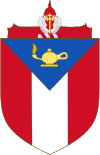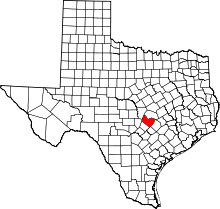Stephen F. Austin
| Stephen Fuller Austin | |
|---|---|
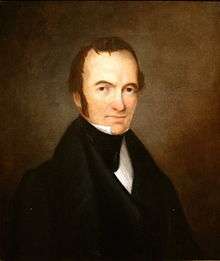 Stephen F. Austin (by an unidentified artist) | |
| Born |
Stephen Fuller Austin November 3, 1793 Wythe County, Virginia, United States known as Austinville today |
| Died |
December 27, 1836 (aged 43) West Columbia, Texas |
| Nationality | American |
| Occupation | empresario |
| Known for | the "Father of Texas" |
| Religion | Anglicanism |
| Parent(s) | Moses Austin, Mary Brown Austin |
| Relatives | Richard Austin (colonist) |
Stephen Fuller Austin (November 3, 1793 – December 27, 1836) was an American empresario born in Virginia and raised in southeastern Missouri. Known as the "Father of Texas", and the founder of Texas,[1][2] he led the second, and ultimately successful, colonization of the region by bringing 300 families from the United States to the region in 1825. In addition, he worked with the Mexican government to support emigration from the United States. He was also granted Mexican nationality when settling Texas.
Numerous places and institutions are named in his honor, including the capital of Texas, Austin in Travis County, Austin County, Austin Bayou, Stephen F. Austin State University in Nacogdoches, Austin College in Sherman, and a number of K-12 schools.
Early years
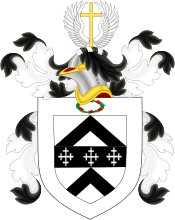
Stephen F. Austin was born in the mining region of southwestern Virginia (Wythe County) in what is known as Austinville today, some 256 miles (412 km) southwest of Richmond, Virginia.[3] He was the second child of Moses Austin and Mary Brown Austin; the first, Eliza, lived only one month. On June 8, 1798, when Stephen was four years old, his family moved west to the lead-mining region of present-day Potosi, Missouri, 40 miles west of the Mississippi River. His father Moses Austin received a sitio[4] from the Spanish government for the mining site of Mine à Breton, established by French colonists. His great-great-grandfather Anthony Austin (b.1636) (son of Richard Austin b.1598) in Bishopstoke, Hampshire, England, he and his wife Esther were original settlers of Suffield, Massachusetts which became Connecticut in 1749.[5]
When Austin was eleven years old, his family sent him back east to be educated, first at the preparatory school of Bacon Academy in Colchester, Connecticut, and then at Transylvania University in Lexington, Kentucky, from which he graduated in 1810.[6] After graduating, Austin began studying to be a lawyer; at age 21, he served in the legislature of the Missouri Territory. As a member of the territorial legislature, he was "influential in obtaining a charter for the struggling Bank of St. Louis."[7]
Left penniless after the Panic of 1819, Austin decided to move south to the new Arkansas Territory.[6] He acquired property on the south bank of the Arkansas River, in the area that would later become Little Rock. After purchasing the property, he learned the area was being considered as the location for the new territorial capital, which could make his land worth a great deal more.[8] He made his home in Hempstead County, Arkansas. Two weeks before the first Arkansas territorial elections in 1820, Austin declared his candidacy for Congress. His late entrance meant his name did not appear on the ballot in two of the five counties, but he still placed second in the field of six candidates. He was later appointed as a judge for the First Circuit Court.[8] Over the next few months, Little Rock did become the territorial capital, but Austin's claim to land in the area was contested, and the courts ruled against him. The Territorial Assembly reorganized the government and abolished Austin's judgeship.[8]
Austin left the territory, moving to Louisiana. He reached New Orleans in November 1820, where he met and stayed with New Orleans lawyer and former Kentucky congressman Joseph H. Hawkins and made arrangement to study law.
Moving to Texas

During Austin's time in Arkansas, his father traveled to Spanish Texas and received an empresarial grant that would allow him to bring 300 American families to Texas[6] called "The Old 300." Moses Austin caught pneumonia soon after returning to Missouri.[6] He left his empresario grant to his son Stephen. Though Austin was reluctant to carry on his father's Texas venture, he was persuaded to pursue the colonization of Texas by a letter from his mother, Mary Brown Austin, written two days before Moses Austin died.[9]
Austin boarded the steamer Beaver and departed to New Orleans to meet Spanish officials led by Erasmo Seguín. He was at Natchitoches, Louisiana, on June 31, 1821, when he learned of his father's death. "This news has effected me very much, he was one of the most feeling and affectionate Fathers that ever lived. His faults I now say, and always have, were not of the heart."[10]
At the age of 24, Austin led his party to travel 300 miles (480 km) in four weeks to San Antonio with the intent of reauthorizing his father's grant, arriving on August 12. While in transit, they learned Mexico had declared its independence from Spain, and Texas had become a Mexican province rather than a Spanish territory. José Antonio Navarro, a San Antonio native with ambitious visions of the future of Texas, befriended Stephen F. Austin, and the two developed a lasting association. Navarro, proficient with Spanish and Mexican law, assisted Austin in obtaining his empresario contracts.[11] In San Antonio, the grant was reauthorized by Governor Antonio María Martínez, who allowed Austin to explore the Gulf Coast between San Antonio and the Brazos River to find a suitable location for a colony.[8] As guides for the party, Manuel Becerra, along with three Aranama Indians, went with the expedition.
Austin advertised the Texas opportunity in New Orleans, announcing that land was available along the Brazos and Colorado rivers.[12] A family of a husband, wife and two children would receive 1,280 acres (520 ha) at twelve and a half cents per acre. Farmers could get 177 acres (72 ha) and ranchers 4,428 acres (1,792 ha). In December 1821, the first U.S. colonists crossed into the granted territory by land and sea, on the Brazos River in present-day Brazoria County, Texas.
Empresario Austin

Austin's plan for an American colony was thrown into turmoil by Mexico's gaining independence from Spain in 1821. Governor Martínez informed Austin that the junta instituyente, the new rump congress of the government of Agustín de Iturbide of Mexico, refused to recognize the land grant authorized by Spain. His government intended to use a general immigration law to regulate new settlement in Mexico. Austin traveled to Mexico City, where he persuaded the junta instituyente to approve the grant to his father, as well as the law signed by the Mexican Emperor on January 3, 1823. The old imperial law offered heads of families a league and a labor of land, 4,605 acres (1,864 ha), and other inducements. It also provided for the employment of agents, called empresarios, to promote immigration. As an empresario, Austin was to receive 67,000 acres of land for each 200 families he brought to Texas. According to the law, immigrants were not required to pay fees to the government. Some of the immigrants denied Austin's right to charge them for services at the rate of 12.5 cents/acre (31 cents/ha).[13]
When the Emperor of Mexico,[14] Agustín de Iturbide, abdicated in March 1823, the law was annulled once again. In April 1823, Austin induced the congress to grant him a contract to bring 300 families into Texas. He wanted honest, hard-working, people who would make the colony a success. In 1824, the congress passed a new immigration law that allowed the individual states of Mexico to administer public lands and open them to settlement under certain conditions. In March 1825, the legislature of the Mexican state of Coahuila y Tejas passed a law similar to the one authorized by Iturbide. The law continued the system of empresarios, as well as granting each married man a league of land, 4,428 acres (1,792 ha), with the stipulation that he must pay the state $30 within six years.
By late 1825, Austin had brought the first 300 families to his settlement, the Austin Colony; these 300 are now known in Texas history as the Old Three Hundred. Austin had obtained further contracts to settle an additional 900 families between 1825 and 1829. He had effective civil and military authority over the settlers, but he was quick to introduce a semblance of American law - the Constitution of Coahuila y Tejas was agreed on in November 1827. Also, Austin organized small, informal armed groups to protect the colonists, which evolved into the Texas Rangers. Despite his hopes, Austin was making little money from his endeavors; the colonists were unwilling to pay for his services as empresario and most of his revenues were spent on the processes of government and other public services.
During these years, Austin, a member of Louisiana Lodge No. 111 at Ste. Genevieve, Missouri, sought to establish Freemasonry in Texas. Freemasonry was well established among the educated classes of Mexican society. It had been introduced among the aristocracy loyal to the House of Bourbon, and the conservatives had total control over the Order. By 1827, Americans living in Mexico City had introduced the United States York Rite of Freemasonry as a liberal alternative to the established European-style Scottish Rite.[15]
On February 11, 1828, Austin called a meeting of Freemasons at San Felipe to elect officers and petition the Masonic Grand Lodge in Mexico City for a charter to form a lodge. Austin was elected Worshipful Master of the new lodge. Although the petition reached Matamoros, and was to be forwarded to Mexico City, nothing more was heard of it. By 1828, the ruling faction in Mexico was afraid the liberal elements in Texas might try to gain their independence. Fully aware of the political philosophies of American Freemasons, the Mexican government outlawed Freemasonry on October 25, 1828. In 1829, Austin called another meeting, where it was decided that it was "impolitic and imprudent, at this time, to form Masonic lodges in Texas."[16]
He was active in promoting trade and currying the good favor of the Mexican authorities, aiding them in the suppression of the Fredonian Rebellion of Haden Edwards. Some historians consider the Fredonian Rebellion to be the beginning of the Texas Revolution. Although "premature ... the Fredonian Rebellion sparked the powder for later success."[17] For this event, Austin raised troops to fight with Mexican troops against the Texas rebels. With the colonists numbering over 11,000 by 1832, they were becoming less amenable to Austin's cautious leadership, and the Mexican government was also becoming less cooperative. It was concerned with the growth of the colony and the efforts of the U.S. government to buy the state from them. The Mexican government had attempted to stop further U.S. immigration as early as April 1830, but Austin's skills gained an exemption for his colonies. He granted land to immigrants based on 640 acres (2.6 km2) to the husband, 320 to the wife, 160 for every child, and 80 for every slave.
Relations with Mexico
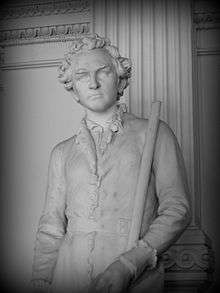
The application off the immigration control of the introduction of tariff laws had done much to dissatisfy the colonists, peaking in the Anahuac Disturbances. Austin became involved in Mexican politics, supporting the upstart Antonio López de Santa Anna. Following the success of Santa Anna, the colonists sought a compensatory reward, proclaimed at the Convention of 1832—resumption of immigration, tariff exemption, separation from Coahuila, and a new state government for Texas. Austin did not support these demands; he considered them ill-timed and tried his hardest to moderate them. When they were repeated and extended at the Convention of 1833, Austin traveled to Mexico City on July 18, 1833, and met with Vice President Valentín Gomez Farías. Austin did gain certain important reforms; the immigration ban was lifted, but a separate state government was not authorized. Statehood in Mexico required a population of 80,000, and Texas had only 30,000.
Austin was arrested by the Mexican government in January 1834 in Saltillo, Coahuila, Mexico under the belief that he was pushing for Texas independence, and was suspected of trying to incite insurrection. He was taken to Mexico City and imprisoned. No charges were filed against him as no court would take jurisdiction. He was moved from prison to prison. He was released under bond in December 1834 and required to stay in the Federal District only. He was fully freed under the general amnesty in July 1835 and in August 1835 left Mexico to return to Texas via New Orleans.
Texas Revolution
In his absence, a number of events propelled the colonists toward confrontation with Santa Anna's centralist government. Austin took temporary command of the Texan forces during the Siege of Béxar from October 12 to December 11, 1835. After learning of the Disturbances at Anahuac and Velasco in the summer of 1835, an enraged Santa Anna made rapid preparations for the Mexican army to sweep Anglo settlers from Texas. War began in October 1835 at Gonzales. The Republic of Texas, created by a new constitution on March 2, 1836, won independence following a string of defeats with the dramatic turnabout victory at the Battle of San Jacinto on April 21, 1836, and the capture of Santa Anna the following morning. He was then imprisoned.
Austin in the Republic of Texas
In December 1835, Austin, Branch Archer, and William H. Wharton were appointed commissioners to the U.S. by the provisional government of the republic. On June 10, 1836, Austin was in New Orleans, where he received word of Santa Anna's defeat by Sam Houston at the Battle of San Jacinto. Austin returned to Texas to rest at Peach Point in August. On August 4, he announced his candidacy for president of Texas. Austin felt confident he could win the election until two weeks before the election, when on August 20, Houston entered the race. Austin wrote, "Many of the old settlers who are too blind to see or understand their interest will vote for him." Houston carried East Texas, the Red River region, and most of the soldiers' votes. Austin received 587 votes to Sam Houston's 5,119 and Henry Smith's 743 votes.
Houston would appoint Austin as the first secretary of state of the new republic; however, Austin served only around two months before his death.
Death and estate
In December 1836, Austin was in the new capital of Columbia (now known as West Columbia) where he caught a severe cold; his condition worsened. Doctors were called in, but could not help him. Austin died of pneumonia at noon on December 27, 1836. He was at the home of George B. McKinstry near what is now West Columbia, Texas. He was 43. Austin's last words were "The independence of Texas is recognized! Don't you see it in the papers?..." Upon hearing of Austin's death, Houston ordered an official statement proclaiming: "The Father of Texas is no more; the first pioneer of the wilderness has departed." Austin was originally buried at Gulf Prairie Cemetery in Brazoria County, Texas. In 1910 Austin's body was reinterred at the Texas State Cemetery in Austin.
Austin never married, nor did he have any children. He bequeathed all his land, titles, and possessions, to his married sister, Emily Austin Perry.
Monuments
- Sherman, Texas, is the home of Austin College.[18]
- Nacogdoches, Texas, is the home of Stephen F. Austin State University.[19]
- Both Austin, Texas, and Austin County, Texas, are named after Stephen F. Austin. However, Austin (the city) is not located in Austin (the county).[20] (Austin, Texas is located in Travis County).[20]
- Angleton, Texas, features a statue of Austin,[21] sponsored by The Stephen F. Austin 500, sculpted by David Adickes, with a base of 12 feet and a total statue height of 72 feet. The base is 2 feet taller than the base of the Sam Houston statue in Huntsville, Texas, but the statue itself is 7-feet shorter. The Sam Houston statue is 67 feet, on a 10-foot base, or 77 feet if you include statue and base.
- The National Statuary Hall Collection permits each state to select just two statues for display at the Capital in Washington, DC. Texas selected Sam Houston and Stephen F. Austin; these statues were sculpted by German immigrant Elisabet Ney.[22]
- Gulf Prairie Cemetery, his original place of burial.[23]
- In 1959, Austin was posthumously inducted into the Hall of Great Westerners at the National Cowboy Hall of Fame in Oklahoma City, Oklahoma.
- In Austinville, Virginia, Austin's birthplace, a monument was erected along the New River near a junction with the New River Trail State Park.
- In Bellville, Texas, the county seat of Austin County, a large bust of Austin by sculptor David Adickes is located at the intersection of State Highways 36 and 159.
The late actor John Carter played Austin in the 1969 episode "Here Stands Bailey" of the syndicated television series Death Valley Days, hosted by Robert Taylor not long before Taylor's own death. In the story line, the hardy, cantankerous pioneer ames Briton "Brit" Bailey (Paul Fix) and his wife, Hannah (Rosemary DeCamp), make their final settlement in southeastern Texas after having overcome many obstacles over the years. Now they face Austin's order that they leave their land. However, Austin has a change of heart and asks them to stay. Bailey dies with his final wish of interment standing upright facing west, hence his grave marker, "Here Stands Bailey Facing West."[24]
Past family
While Stephen F. Austin and his sister Emily have each been subject of biography, they are descended from several generations of noteworthy people, including: Moses Austin (father—biography published by Trinity University Press),[25] Abia Brown (grandfather), Joseph Sharp (great grandfather), Isaac Sharp (great, great grandfather), Anthony Sharp (great, great, great grandfather—biography published by Stanford University Press).[26] Accordingly, history records noteworthy social contribution in each generation of Stephen's family dating back to the early 17th century.
See also
- Moses Austin, his father
- Mary Brown Austin, his mother
- James Elijah Brown Austin, his brother
- Emily Austin Perry, his sister
- Abia Brown, his maternal grandfather
- José María Jesús Carbajal Mentored by Austin
- Joseph Sharp, great grandfather
- Isaac Sharp, his great, great grandfather
- Anthony Sharp, his great, great, great grandfather
- Peach Point Plantation, his residence
- Jones Creek, site of his residence
- Thomas J. Pilgrim, his friend and Spanish interpreter
- James Bryan, his brother-in-law (first husband to Emily)
- James Franklin Perry, his brother-in-law (second husband to Emily)
- List of Notable Freemasons
- O. P. Q. Letters
Footnotes
- ↑ Gregg Cantrell (1 August 2001). Stephen F. Austin: Empresario of Texas. Yale University Press. p. 2. ISBN 0-300-09093-5.
...generations of Texans have come to revere Austin as the Father of Texas...
- ↑ Thom Hatch (1 August 1999). Encyclopedia of the Alamo and the Texas Revolution. McFarland. p. 44. ISBN 978-0-7864-9162-9.
- ↑ "Stephen Fuller Austin --Biography".
- ↑ Lonestar Text book
- ↑ Anthony Austin (1635) Austin family ancestry
- 1 2 3 4 Edmondson (2000), p. 59.
- ↑ "AUSTIN, STEPHEN F. | The Handbook of Texas Online| Texas State Historical Association (TSHA)". Tshaonline.org. Retrieved December 11, 2011.
- 1 2 3 4 Edmondson (2000), p. 60.
- ↑ Austin, Mary Brown, Texas Handbook of History Online
- ↑ Letter from Stephen F. Austin to Maria Austin, July 13, 1821
- ↑ Todish (1998), p. 107.
- ↑ Edmondson (2000), p. 61.
- ↑ https://tshaonline.org/handbook/online/articles/fau14
- ↑ "ITURBIDE, AGUSTIN DE | The Handbook of Texas Online| Texas State Historical Association (TSHA)". Tshaonline.org. Retrieved July 10, 2013.
- ↑ Normand, Pete (1986). The Texas Masons: The Fraternity of Ancient Free & Accepted Masons in the History of Texas. College Station, TX: Brazos Valley Masonic Library & Museum Assn.
- ↑ Carter, Dr. James D. (1955). Masonry in Texas: Background, History, and Influence to 1846. Waco, Texas: Committee on Masonic Education and Service, Grand Lodge of Texas, A.F. & A.M.
- ↑ Bates (1956), p. 794.
- ↑ "Austin College: Sherman, Texas". Austincollege.edu. Retrieved December 11, 2011.
- ↑ "Stephen F. Austin State University | College, University in Texas". Sfasu.edu. Retrieved December 11, 2011.
- 1 2 "The Official Web Site of Travis County, USA". Co.travis.tx.us. November 5, 2011. Retrieved December 11, 2011.
- ↑ "Stephen F Austin statue Clute 02 photo - Artichoke Vinaigrette photos at". Pbase.com. November 27, 2005. Retrieved December 11, 2011.
- ↑ "Texas and the U.S. Capitol Building". Texasbob.com. Retrieved December 11, 2011.
- ↑ "Area Museums and Landmarks". Gulf-prairie.org. Retrieved December 11, 2011.
- ↑ "Here Stands Bailey on Death Valley Days". Internet Movie Data Base. February 18, 1969. Retrieved July 13, 2015.
- ↑ Gracy, David B., Moses Austin: his life (Trinity University Press, 1987) ISBN 0-911536-84-1
- ↑ Greaves, Richard L. (1998), Dublin's merchant-Quaker: Anthony Sharp and the Community of Friends, 1643-1707, Stanford, CA: Stanford University Press, ISBN 978-0-8047-3452-3
References
- Edmondson, J.R. (2000). The Alamo Story-From History to Current Conflicts. Plano, TX: Republic of Texas Press. ISBN 1-55622-678-0.
- Hendrickson, Kenneth E., Jr. (1995). The Chief of Executives of Texas: From Stephen F. Austin to John B. Connally, Jr. College Station, Texas: Texas A&M University Press. ISBN 0-89096-641-9.
- Todish, Timothy J.; Todish, Terry; Spring, Ted (1998). Alamo Sourcebook, 1836: A Comprehensive Guide to the Battle of the Alamo and the Texas Revolution. Austin, TX: Eakin Press. ISBN 978-1-57168-152-2.
Further reading
- Barker, Eugene Campbell (1968). The Life of Stephen F. Austin, Founder of Texas, 1793–1836: A Chapter of the Westward Movement by the Anglo-American People (2nd ed.). Da Capo Press.
- Beals, Carleton (1953). Stephen F. Austin, Father of Texas. McGraw-Hill.
- Cantrell, Gregg (2001). Stephen F. Austin: Empresario of Texas. Yale University Press. ISBN 978-0-300-09093-2.
- Flynn, Jean (1981). Stephen F. Austin, the Father of Texas. Eakin Press. ISBN 978-0-585-16421-2.
- Glasscock, Sallie (1951). Dreams of an Empire: The Story of Stephen Fuller Austin and His Colony in Texas. Naylor Co.
- Tracy, Milton Cook; Havelock-Bailie, Richard (1941). The Colonizer: A Saga of Stephen F. Austin. Guynes Print Co.
- Warren, Betsy (1996). Moses Austin and Stephen F. Austin: A Gone to Texas Dual Biography. Hendrick-long Pub. Co. ISBN 978-0-937460-96-2.
- Jones, Marie Beth (1982). Peach Point Plantation: The First 150 Years. Texian Press. ISBN 0-9630042-0-4.
External links
| Wikimedia Commons has media related to Stephen F. Austin. |
- Stephen Fuller Austin from the Handbook of Texas Online
- Stephen F. Austin at Find a Grave
- Ellis P. Bean, Stephen F. Austin, hosted by the Portal to Texas History.
- Biography of Stephen F. Austin from The Biographical Encyclopedia of Texas, hosted by the Portal to Texas History.
- Austin's Colonization Laws, 1822 from Gammel's Laws of Texas, Vol. I. hosted by the Portal to Texas History.
| Diplomatic posts | ||||||||||||||
|---|---|---|---|---|---|---|---|---|---|---|---|---|---|---|
| Preceded by post created |
Texas Commissioner to the United States 1835 - 1836 served alongside William H. Wharton and Branch T. Archer |
Succeeded by unique post for support of Texas independence | ||||||||||||
Political offices
| ||||||||||||||
